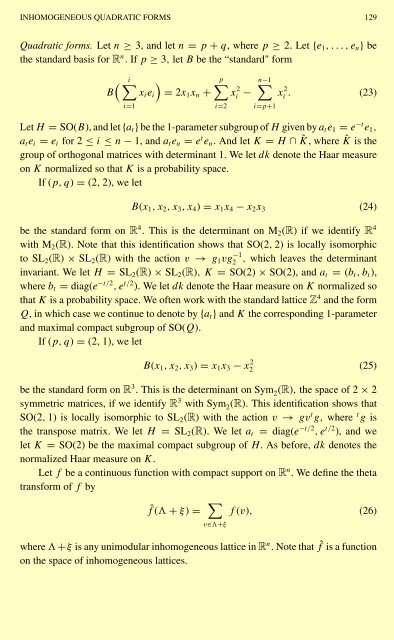NEAR OPTIMAL BOUNDS IN FREIMAN'S THEOREM
NEAR OPTIMAL BOUNDS IN FREIMAN'S THEOREM
NEAR OPTIMAL BOUNDS IN FREIMAN'S THEOREM
You also want an ePaper? Increase the reach of your titles
YUMPU automatically turns print PDFs into web optimized ePapers that Google loves.
<strong>IN</strong>HOMOGENEOUS QUADRATIC FORMS 129<br />
Quadratic forms. Let n ≥ 3, andletn = p + q, where p ≥ 2. Let {e1,...,en} be<br />
the standard basis for R n . If p ≥ 3, let B be the “standard" form<br />
i<br />
B<br />
i=1<br />
xiei<br />
<br />
= 2x1xn +<br />
p<br />
i=2<br />
x 2<br />
i −<br />
n−1<br />
i=p+1<br />
x 2<br />
i . (23)<br />
Let H = SO(B),andlet{at} be the 1-parameter subgroup of H given by ate1 = e −t e1,<br />
atei = ei for 2 ≤ i ≤ n − 1, andaten = e t en. And let K = H ∩ ˆK, where ˆK is the<br />
group of orthogonal matrices with determinant 1. We let dk denote the Haar measure<br />
on K normalized so that K is a probability space.<br />
If (p, q) = (2, 2), welet<br />
B(x1,x2,x3,x4) = x1x4 − x2x3<br />
be the standard form on R4 . This is the determinant on M2(R) if we identify R4 with M2(R). Note that this identification shows that SO(2, 2) is locally isomorphic<br />
to SL2(R) × SL2(R) with the action v → g1vg −1<br />
2 , which leaves the determinant<br />
invariant. We let H = SL2(R) × SL2(R), K = SO(2) × SO(2), andat = (bt,bt),<br />
where bt = diag(e −t/2 ,e t/2 ). We let dk denote the Haar measure on K normalized so<br />
that K is a probability space. We often work with the standard lattice Z 4 and the form<br />
Q, in which case we continue to denote by {at} and K the corresponding 1-parameter<br />
and maximal compact subgroup of SO(Q).<br />
If (p, q) = (2, 1), welet<br />
B(x1,x2,x3) = x1x3 − x 2<br />
2<br />
be the standard form on R3 . This is the determinant on Sym2(R), the space of 2 × 2<br />
symmetric matrices, if we identify R3 with Sym2(R). This identification shows that<br />
SO(2, 1) is locally isomorphic to SL2(R) with the action v → gvtg, where tg is<br />
the transpose matrix. We let H = SL2(R). We let at = diag(e−t/2 ,et/2 ),andwe<br />
let K = SO(2) be the maximal compact subgroup of H. As before, dk denotes the<br />
normalized Haar measure on K.<br />
Let f be a continuous function with compact support on Rn . We define the theta<br />
transform of f by<br />
f ˆ(<br />
+ ξ) = <br />
f (v), (26)<br />
v∈+ξ<br />
where +ξ is any unimodular inhomogeneous lattice in R n . Note that ˆ<br />
f is a function<br />
on the space of inhomogeneous lattices.<br />
(24)<br />
(25)

















